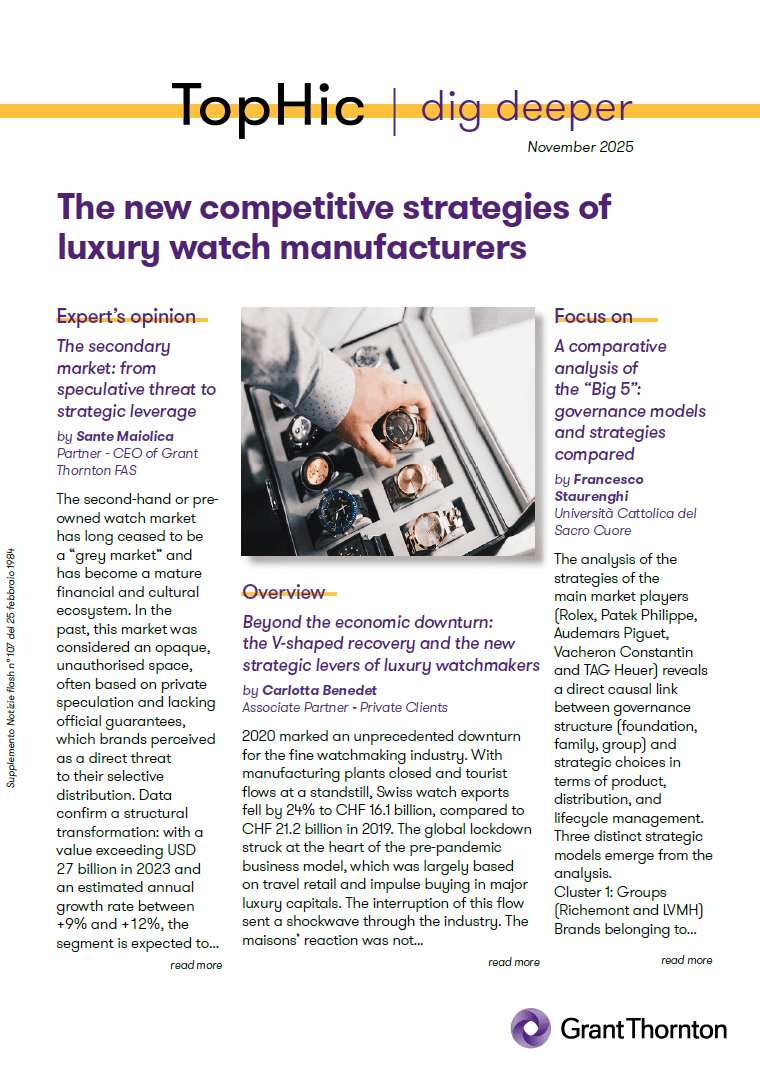
The second-hand or pre-owned watch market has long ceased to be a "grey market" and has become a mature financial and cultural ecosystem. In the past, this market was considered an opaque, unauthorised space, often based on private speculation and lacking official guarantees, which brands perceived as a direct threat to their selective distribution. Data confirm a structural transformation: with a value exceeding USD 27 billion in 2023 and an estimated annual growth rate between +9% and +12%, the segment is expected to reach parity with the market of new watches by 2030.
This evolution is forcing the maisons to rethink their business models, positioning the secondary market as the new strategic arena for pricing control, brand image and sustainability credentials.
The segment’s growth is led not only by the scarcity of new items, but rather by a new type of consumer: Gen Z already represent 20% of buyers in this channel. For them, pre-owned items are not a second choice, but a smart and, ultimately, more sustainable entry into the world of luxury.
The ecosystem which feeds this growth has reached near-financial transparency. Platforms such as Chrono24 are not mere marketplaces, but rather global hubs with over 9 million users per month. The introduction of indexes such as the ChronoPulse index, an actual “watch exchange” based on hundreds of thousands of real transactions, has turned watches into a liquid asset class. This means that a watch can be converted into cash as easily, or almost as easily, as stock, with a price determined by the global market rather than by a subjective estimate. Watches thus become part of the alternative investment portfolio, alongside art and fine wines, but with significantly greater liquidity and data transparency. This also leads to a power shift: value is no longer defined solely by the watchmakers, but by a global and transparent market.
For decades, brands have either fought or ignored this phenomenon. They feared the dilution of the exclusivity of their image, the loss of direct contact with end customers (intercepted by third-party retailers) and the the impossibility to control the narrative surrounding their products once they left the boutiques. Now, the strategic threat of losing control over pricing and image has forced them to take action. Rolex’s reaction was the most decisive: first of all, it launched its Certified Pre-Owned (CPO) programme in 2022 and then proceeded with the strategic acquisition of Bucherer in 2023.
The Bucherer acquisition was not a case of “land grabbing” in retail but rather led to the creation of a closed ecosystem. By controlling Bucherer, Rolex not only secured a primary sales channel, but also acquired the infrastructure for the collection, certification and resale on the secondary market. This is a move to manage speculation and capture margins across the entire, and now perpetual, product lifecycle, regaining control of brand value. This also sets a new standard: the goal is no longer that of defeating the secondary market, but rather to assimilate and control it, making it an extension of the corporate strategy.
This is the new strategic arena. With a secondary market that could exceed USD 35 billion by 2030, managing speculation becomes crucial to avoid bubbles which could damage the brand. At the same time, the ESG challenge is emerging: 78% of industry executives consider sustainability a strategic priority. The two challenges are interrelated. An official CPO program is actually a circular economy strategy: It is not just about “recycling”, but about “re-marketing” luxury. Extending the lifecycle of a complex mechanical product, designed to last for generations is the highest form of sustainability. A CPO program reduces the pressure on the raw materials supply chain (steel, gold, precious stones), as well as the total carbon footprint, as the energy cost of restoration is minimal compared to the creation of a new watch.
The winning maisons will be those controlling the entire lifecycle of their products, turning sustainability and CPO into a tangible competitive advantage.
Other brands are thus expected to replicate Rolex strategy, creating their CPO infrastructures or acquiring specialised retailers to gain direct control on the data set of second-hand transactions.
Digitalisation will play a key role in traceability and certification. The use of blockchain technology to register property, authenticity and service history of each single pre-owned watch is the natural evolution of this path. This will guarantee the maximum transparency required, eliminating the risk of counterfeiting and certifying the residual value with unassailable financial precision.
